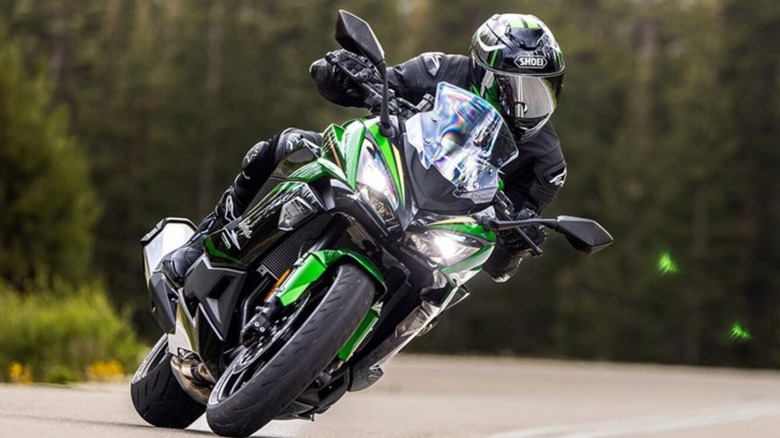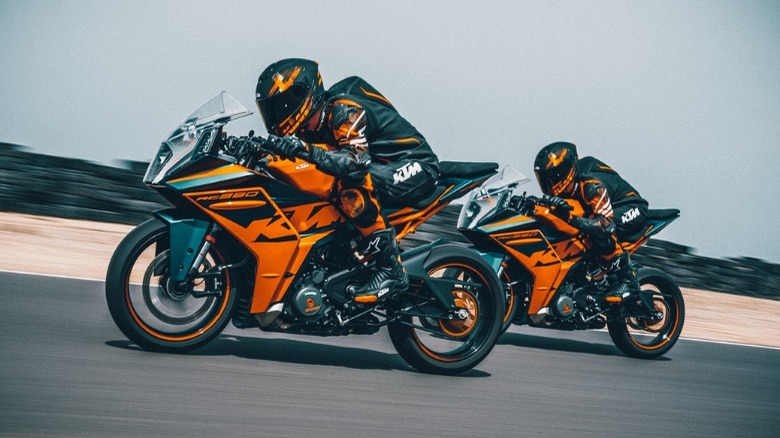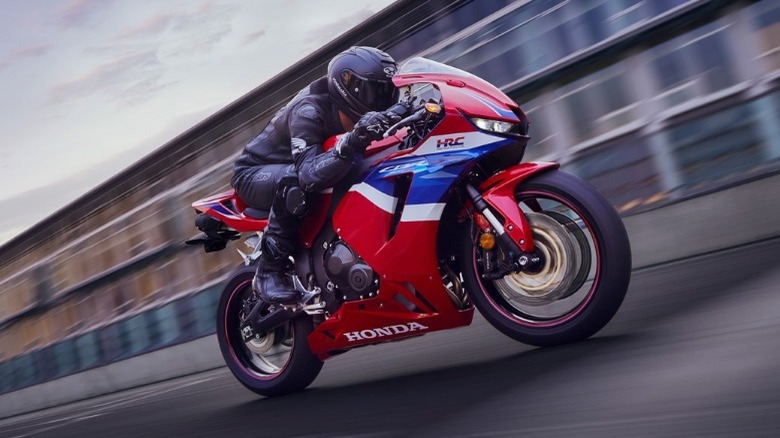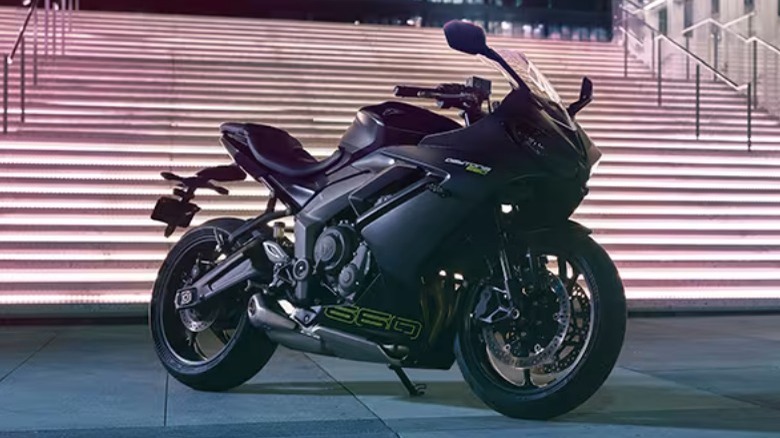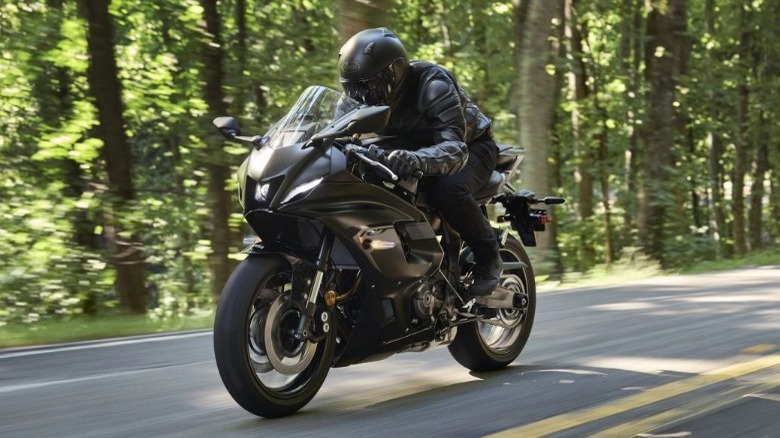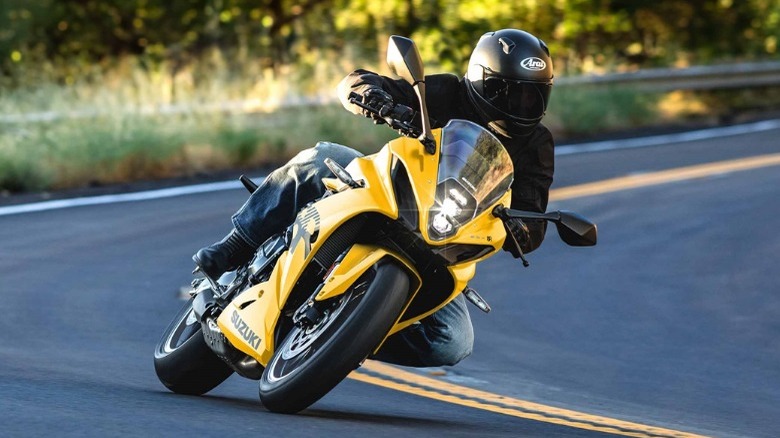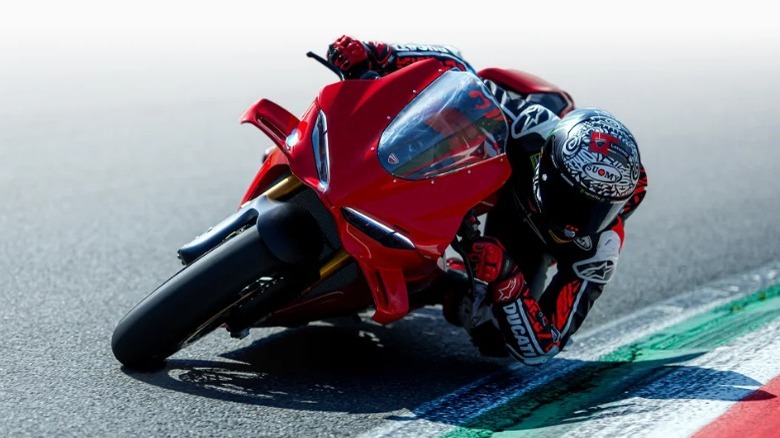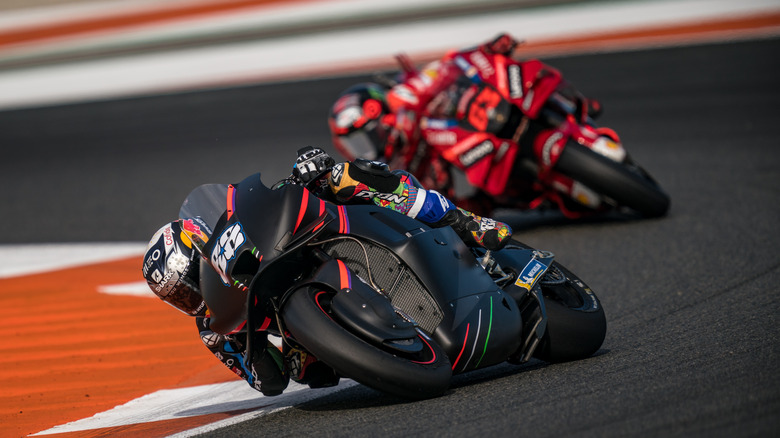6 Of The Best Non-Kawasaki Sport Bikes To Consider In 2024
Kawasaki's Ninja motorcycles are some of the most well-regarded sport bikes on the market. There are 14 different models of Ninja currently available across a range of performance specifications and engine sizes, including an e-bike and a hybrid. The smaller models are considered to be among the best bikes for new riders to learn on, and many of their larger-engine bikes are popular with more experienced riders. There are a lot of factors that have contributed to Kawasaki's success in the sport bike category, but affordability, performance, and reliability are often cited as some of the brand's most compelling traits.
That said, it's far from the only brand out there that makes sport bikes. Several other manufacturers make excellent performance motorcycles that are great for everything from urban commutes to weekends at the track. Some of them offer a similar range of affordability to the bikes in Kawasaki's line-up, while others push the boundaries of performance to their absolute limits.
Those who are thinking about getting a new bike and have already seen what Kawasaki has to offer might want to know what else is out there. One of the best ways to find alternatives is to look up the lineups of some of the most popular manufacturers on the market and see which models stand out the most in each engine-size-class. Based on personal experience and professional hands-on reviews, here are six of the best non-Kawasaki sport bikes from different brands across the entire spectrum of engine sizes that you might want to consider in 2024. There will be a more in-depth explanation of our methodology at the end of the article.
KTM RC 390
Kawasaki hasn't made a lot of smaller motorcycles since it discontinued the Ninja 250. The smallest bike that the company currently manufactures is the 399cc Ninja ZX-4R. This is a good bike, but an excellent alternative is the 2024 KTM RC 390. KTM is an Austrian company that is well-known in the motorsports world. The company's products tend to be a bit more expensive than its Japanese counterparts, but both its dirt bikes and its street bikes have a well-earned reputation for reliability and performance.
The RC 390 is a high-performance supersport bike that runs on a 373cc, liquid-cooled, single-cylinder four-stroke engine with a six-speed transmission and a slipper clutch. This engine produces a modest 43 horsepower and 27 lb-ft of torque, making it a solid option for new riders, lighter riders, and those who might be intimidated by a larger engine. As Cycle World said in its review, "The RC 390 isn't a stallion like the 890 Duke or a draught horse like the 1290 Super Adventure. It's a pony. But a really peppy pony."
Outside of its raw performance specifications, the bike also has a lightweight frame with a design that is meant to maximize the rider's contact with the motorcycle, giving them more control. Its suspension is composed of a 43-millimeter WP Apex open cartridge front fork and rebound and preload adjustable split-piston WP Apex shock absorber in the rear. As for features, the RC 390 has a DFT dash display, MTC traction control, cornering ABS, and a quick shifter similar to those used in several Kawasaki motorcycles. That's a lot of bells and whistles for a sub-400cc motorcycle.
Honda CBR600RR
Honda has been the best-selling motorcycle manufacturer in the world for over half a century. The company makes a wide variety of different kinds of motorcycles, but its overall success is due, in no small part, to its sport bikes. Every bike in the Honda CBR line is ranked among the best in its class, but one that stands out more than most is the 2024 CBR600RR. The RR in the name stands for Race and Relay, because this particular model is designed to be even more aggressive than the more street-oriented CBRs, and making it most similar to the Kawasaki Ninja ZX-6R.
The bike is powered by a 599cc, DOHC, liquid-cooled, inline four-cylinder engine with four valves per cylinder. It has a 67-millimeter bore, a 42.5-millimeter stroke, a 12.2:1 compression ratio, Dual-Stage Fuel Injection, and a close-ratio six-speed transmission. This allows the bike to put out 100 horsepower at 12,900 RPM and 44 lb-ft of torque at 10,900 RPM. The suspension is composed of a 41-millimeter inverted Big Piston Fork in the front and a Unit Pro-Link HMAS single shock in the back.
The CBR600RR is my current ride, and one of the great things that I've found about this bike is that it has the competitive feel and aggressive riding style of a larger supersport, but with the lighter weight and easier control associated with its mid-sized engine. It has a centrally located fuel tank to keep the weight balanced, and Honda's electronic steering damper. The zippy acceleration and tight cornering make you feel like you're racing on the track even as you're winding your way down a canyon road.
Triumph Daytona 660
The next step-up is the mid-sized Triumph Daytona 660. Triumph Motorcycles is a U.K.-owned brand that's well respected for its street bikes, but the Daytona 660 is currently the only sport bike in its 2024 lineup. The bike is powered by a three-cylinder engine that has 93 horsepower at 11,250 RPM and 51 lb-ft of torque starting at 3,125 RPM, placing it in a similar category to the Kawasaki Ninja 650. This is interesting because it puts more of an emphasis on zippy torque with a low center of gravity than it does in raw power output and overall speed.
"On the road, this translates to accessible sports performance that suits every riding scenario, and every rider's style," Triumph states. "This effortless engine performance is complemented by a super-slick six-speed gearbox and Triumph's Slip-and-Assist clutch. With a light lever action and progressive take-up, stop/start urban commutes are a cinch." The Daytona 660 also places the rider in a comfortable and balanced riding position by placing the handlebars above the top yoke. It combines a 32-inch seat height with a narrow standover to make it approachable for riders in a wide range of heights and weights.
So in many ways, this is the opposite of the CBR600RR. While Honda maximized racing performance, Triumph leaned into the smooth handling and rapid starting response that's easier to appreciate in urban riding. "It may not be a hardcore supersport racebike," says Cycle World, "but as an all-arounder it is a fun and spirited motorcycle that has none of the shortcomings that those machines have in real-world riding."
Yamaha YZF-R7
Yamaha only makes five motorcycles in the supersport category. This might seem like a fairly small selection in comparison with Kawasaki's massive inventory, but every single motorcycle in the Yamaha lineup is among the best in its class. This is a big part of the reason that the company is ranked among the best major motorcycle brands on the market. The Yamaha YZF-R7 is only slightly larger than the Daytona, but it's a more performance-forward option that you can get for roughly the same price. This is another bike that you could compare to the ZX-6R, but while the Honda was a bit smaller, the Triumph is a solid step bigger. This makes it very compelling for riders who want a reasonably affordable midsized bike that will do as well on the racetrack as it does on the street.
The R7 runs on a 689cc liquid-cooled, four-stroke, DOHC inline twin-cylinder engine with 4-valves per cylinder. It has an 80.0-millimeter bore, a 68.6-millimeter stroke, an 11.5:1 compression ratio, and a six-speed transmission. This gives it 66.32 horsepower at 8,610 RPM and 45.72 lb-ft of torque at 6,380 RPM. The suspension is composed of a telescopic fork with 5.1-inch travel in the front and a linked-type Monocross shock in the back. It has titanium connecting rods, titanium intake valves, and forged aluminum pistons.
The R7 also has an assist and slipper clutch, an optional quick shift system, an LCD instrument display, and an adaptive LED headlight. All of this adds up to a bike that's all thrills and very few frills. As Rider Magazine says, "The R7 could be the perfect bike for someone who wants to sharpen their skills on back roads or try their hand at track days or club racing."
Suzuki GSX-8R
When it comes to Japanese sport bikes, the three names that you typically think of alongside Kawasaki are Honda, Yamaha, and Suzuki. There was a time when Suzuki was seen as something of an underdog in the sport bike arena, but the company has been neck and neck with its competitors for a while now.
The Suzuki GSX-8R takes a particularly interesting place in the company's lineup. It's bigger than most mid-sized bikes on the market while still being smaller and more affordable than the monsters like the Kawasaki Ninja 1000 SX, with Suzuki just barely keeping its price under five figures. The bike is powered by a 776cc, four-stroke, liquid-cooled, DOHC parallel twin engine with an 84.0-millimeter bore, a 70-millimeter stroke, a 12.8:1 compression ratio, and a six-speed transmission. This gives the bike up to 82 horsepower and 58 lb-ft of torque, allowing it to easily outclass the YZF-R7 and just about any other midsized bike from its competitors. Cycle World was impressed with this bike as well, claiming, "the 8R provides a level of performance that exceeded our expectations both on the track and on the street."
The GSX-8R isn't just about raw power, though. It has a few other interesting features as well. The transmission output is managed by the Suzuki Clutch Assist System (SCAS), which works similarly to an assist and slipper clutch while also offering bi-directional quick shifter functionality for clutchless upshifting and downshifting. The suspension is made up of a Showa SFF-BP inverted fork with 41-millimeter inner tubes in the front and a link-type rear suspension with a Showa mono-shock in the back. The bike also has a 5-inch LCD instrument panel, an electronic throttle system powered by a dual-processor ECM, an S-DMS system that allows the rider to choose from three different power output modes, and a traction control system.
Ducati Panigale V4 S
Most of the companies that make sport bikes have at least one 1,000cc-class option, with some offering specialty top-of-the-line models like the Honda Fireblade, the Yamaha YZF-R1M, the Suzuki Hayabusa, or the Kawasaki H2 series motorcycles. European companies have a few bikes in this category as well, but few compare to the Ducati Panigale V4 S.
An Italian company, Ducati has frequently been referred to as 'the Ferrari of motorcycles' and bikes like the Panigale make it easy to see why. This bike is powered by the Desmosedici Stradale – a 1,103cc V-4 that can produce up to 216 horsepower at 13,500 RPM and 89.2 lb-ft of torque at 11,250 RPM in the Panigale V4. This engine's name comes from a proprietary technology that Ducati calls the Desmodromic System, which "uses components that have been completely redesigned and miniaturised to obtain very compact heads, achieving a level of sophistication, compactness and lightness never seen before on a Ducati bike."
The bike also has a ton of features. It has a 6.9-inch instrument panel, Ducati Vehicle Observer (DVO) electronic controls, and an e-CBS brake control system that replaces ABS which applies autonomous rear braking pressure. It also has a Öhlins suspension and steering damper which is controlled by a third-generation SmartEC 3.0 system, four different engine mode configurations that control power output, five different Advanced Riding Modes that are designed to account for different riding conditions, Ducati Quick Shift 2.0, and much more. This is why Motorcycle.com said that this bike was "the most capable turnkey track day bike ever produced. Massively capable, with trickle-down MotoGP technology, but with multiple options to tame the beast."
Our methodology
I've been riding sport bikes for over a decade and am very familiar with the qualities that many riders find appealing in a performance motorcycle. In composing this list, I started by taking a look at the current models available from some of the biggest and most popular manufacturers on the market. I specifically looked for bikes that had specs, features, and prices which were competitive with those in the current Kawasaki line up. I then deliberately selected only one motorcycle from each manufacturer in order to provide readers with a wide sampling of the different options that are available across the entire spectrum of engine sizes.
From there, I listed the specifications and features of each motorcycle in order to highlight the qualities that make them stand out as worthy alternatives to their Kawasaki counterparts. In the instance of the Honda CBR600RR, I shared my own personal experience with the bike. For the other models, I examined and shared reviews from reputable professional outlets so that readers could have a better idea of how these bikes stand up to real world performance testing.
